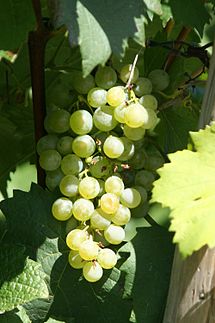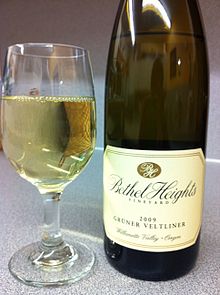- Grüner Veltliner
-
Grüner Veltliner Grape (Vitis) 
Color of berry skin Blanc Species Vitis vinifera Also called Grüner Muskateller, Veltliner (more) Origin Austria? Notable regions Lower Austria, Burgenland, Moravia, Czech Republic Notable wines Smaragds from Wachau Grüner Veltliner (German pronunciation: [ˈɡʀyːnɐ vɛltˈliːnɐ]) is a variety of white wine grape variety grown primarily in Austria, Slovakia, and the Czech Republic. It has a reputation of being a particularly food-friendly wine.[1] It is made into wines of many different styles - much is intended for drinking young in the Heuriger (bars serving new wine) of Vienna, a little is made into sparkling wine, but some is capable of long aging. The steep, Rhine-like vineyards of the Danube west of Vienna produce very pure, minerally Grüner Veltliners intended for laying down. Down in the plains, citrus and peach flavours are more apparent, with spicy notes of pepper and sometimes tobacco.
Contents
History
It is sometimes said that Grüner Veltliner dates back to Roman times and that its name is derived from Veltlin (Valtellina) in northern Italy. However, the current name appeared in a document for the first time in 1855 - before that time it was known as Weißgipfler.[2][3] Only by the 1930s was Grüner Veltliner established as the standard name of the grape. Until the Second World War it was regarded as just another Austrian grape, it took Lenz Moser's Hochkultur system of vine training to really get the best out of it, and it expanded quickly in plantation from the 1950s to later become Austria's most planted variety.[2] Since the antifreeze scandal of 1985, Grüner Veltliner has been at the forefront of the switch in Austrian winemaking towards better quality dry wines.
Pedigree
Some ampelographers (such as Hermann Goethe in his famous 1887 handbook of ampelography) have long assumed that Grüner Veltliner is not related to the other varieties with "Veltliner" in their name (such as Roter Veltliner), or that it is only distantly related.[3] Neither has it been assumed to be related to the Muscat family, despite the old name "Grüner Muskateller" (Muskateller is the German designation for Muscat).
A first DNA analysis in the late 1990s secured Traminer as one parent of Grüner Veltliner, but was not able to identify the other parent among the candidates studied.[2] The other parent was later found to be an originally unnamed variety of which only a single, abandoned, very old and weakened vine was found in St. Georgen outside Eisenstadt in Austria. It is therefore referred to as St. Georgener-Rebe, "St. Georgen-vine". The vine was found in 2000 in an overgrown part of a pasture in a location where there had not been any vineyard since the late 19th century, and is assumed to have been the last vine in this location for over a century. Local experts were not able to determine the variety of the vine. Only when it was threatened to be ripped out in 2005 additional samples were taken and later analysed at Klosterneuburg. Genetic analysis in the following years by Ferdinand Regner was able to determine that St. Georgener-Rebe is a parent variety to Grüner Veltliner.[3][4][5] The parents of this variety have not been determined. Plans exist to bring the variety into experimental cultivation in order to assess its viticultural properties.
Distribution and wines
Austria
In 2008, Grüner Veltliner plantations in Austria stood at 17,151 hectares (42,380 acres), and it accounts for 32.6% of all vineyards in the country, almost all of it being grown in the northeast of the country.[6] Along the Danube to the west of Vienna, in Wachau, Kremstal and Kamptal, it grows with Riesling in terraces reminiscent of the Rhine, on slopes so steep they can barely retain any soil. The result is a very pure, minerally wine capable of long ageing, that stands comparison with some of the great wines of the world. In recent blind tastings organised by the Austrian Wine Marketing Board, Grüner Veltliners have beaten world-class Chardonnays from the likes of Mondavi and Maison Louis Latour.[7]
In the deeper clay soils in the Weinviertel to the northeast of Vienna Grüner Veltliner develops more of a spicy, peppery character, which can be aged although a lot of production is intended to be drunk young in the heurigen bars of Vienna. Some is made into sparkling wine in the far northeast around Poysdorf.
A little is grown south of Vienna, in the warmer climates of the vineyards towards the Hungarian plains, although the growers there are more interested in red and dessert wines.
Two of the first three DACs (geographical appellations) in Austria apply to Grüner Veltliner, the Weinviertel DAC and the Traisental DAC.
Slovakia
Grüner Veltliner is the most popular wine group in country standing at 2,756 hectares (6,810 acres)
Czech Republic
The Czech Republic, particularly southern Moravia close to the Austrian border (wine subregion Mikulovská), produces some Grüner Veltliners of notable quality. Grüner Veltliner is the second most widely grown white grape variety in the Czech Republic, encompassing approximately 2,120 hectares (5,200 acres) and resulting in approximately 11% of Czech wine production.[8]
Hungary
A little is grown in Austria's former imperial partner.
United States
In recent years a few US wineries have started to grow and bottle Grüner Veltliner, including wineries and vineyards in Oregon, Maryland, the Finger Lakes region of New York State, Napa Valley, Clarksburg AVA and Santa Ynez Valley AVA.
New Zealand
The variety is now being experimented with by a number of winemakers in New Zealand including Spade Oak in the Gisborne region.
Grüner Veltliner in Australia
Grüner Veltliner is now cultivated in Australia and especially in the Adelaide Hills wine region of South Australia. This region is particularly suited to the growing of this variety because of its specific combination of a low Mean January Temperature (MJT) and an associated high diurnal variation. Three clones were imported into Australia in 2006 by Hahndorf Hill Winery in the Adelaide Hills and have since been propagated and planted extensively across the region. There will be about a dozen growers by spring 2011 in this cool-climate region. Australia's first production was the Lark Hill Grüner Veltliner (Canberra region) in 2009 and this was followed closely in 2010 by the first Hahndorf Hill Winery vintage.
Vine and viticulture
The leaves are five-lobed and the bunches are long but compact, with deep green grapes that ripen in mid-late October.
Synonyms
Grüner Veltliner, which colloquially is sometimes referred to as GrüVe, is also known under the following synonyms:[9] Bielospicak, Cima Biancam, Dreimänner, Feherhegyü, Feldlinger, Green Veltliner, Grün Muskateller, Grüne Manhardsrebe, Grüner, Grüner Muskateler, Grüner Muskateller (in common usage until the 1930s), Grüner Velteliner, Grüner Weissgipfler, Grüner Weltliner, Grünmuskateller, Gruner Veltliner, Manhardsrebe, Manhardtraube, Manhartsrebe, Mauhardsrebe, Mouhardrebe, Mouhardsrebe, Muskatel, Muskatel Zeleny, Nemes Veltelini, Plinia Austriaca, Ranfol Bianco, Ranfol Bijeli, Ranfol Weisser, Rdeci Veltinec, Reifler Weiss, Ryvola Bila, Tarant Bily, Valtelin Blanc, Valtelina Vert, Valteliner, Valteliner Blanc, Valteliner Vert, Velteliner Grüner, Velteliner Vert, Velteliner Weisser, Veltelini Zöld, Veltlin Zeleny, Veltlinac Zeleni, Veltlinec, Veltliner, Veltliner Blanc, Veltliner Grun, Veltliner Gruner, Veltliner Grün, Veltliner Verde, Veltlini, Veltlínské Zelené,[10] Veltlinski Zelenii, Veltlinsky Vert, Veltlinsky Zeleny, Vetlinac, Vetlinac Zeleni, Weisser Raifler, Weisser Reifler, Weisser Valteliner, Weisser Velteliner, Weisser Veltliner, Weissgipfler, Weissgipfler Grüner, Yesil Veltliner, Zeleni Vetlinac, Zeleny Muskatel, Zleni Veltinac, Zöld Muskotally, Zöld Muskotalynak, Zöld Veltelini, Zöld Velteliny, Zöldveltelini, Zold Veltelini.
Clones, crossings and mutations
Two other Austrian varieties with "Veltliner" in their names, Roter Veltliner and Frühroter Veltliner, are not related to Grüner Veltliner.
See also
References
- ^ Robinson, Jancis Vines, Grapes & Wines Mitchell Beazley 1986 ISBN 1-85732-999-6
- ^ a b c "Grüner Veltliner – Austrias Secret Weapon". Austrian Wine Marketing Service. April 2006. http://www.winesfromaustria.com/wine/download/pie_gv.pdf. Retrieved 2007-04-26.
- ^ a b c Wein-Plus Glossar: Grüner Veltliner, accessed 2010-06-23 (German)
- ^ Elternteil des Grünen Veltliners gefunden, Der Winzer 2009-08-06 (German)
- ^ Pressemappe zum Pressegespräch „Vater (-rebe) des Grünen Veltliner gefunden“, 2009-08-06 (German)
- ^ Österreich Wein: Dokumentation 2009 - Aufbau Weinland Österreich - Teil 1, p. 36, accessed on November 9, 2009 (German)
- ^ Robinson, Jancis (2002-11-16). "Grüner Veltliner - distinctly groovy grape". jancisrobinson.com. http://www.jancisrobinson.com/articles/jr8920. Retrieved 2007-04-26.
- ^ Wine of Czech Republic: Statistics and Charts, accessed July 1, 2011
- ^ Vitis International Variety Catalogue: Veltliner Gruen, accessed on December 27, 2009
- ^ Robinson, Jancis. "Grüner Veltliner". http://www.jancisrobinson.com/articles/20070301_3. Retrieved 26 December 2009.
External links
- Grape varieties in Austria: Grüner Veltliner Austrian Wine Marketing Service
- Grüner Veltliner An Introduction
Wines General Wine styles Grape varieties International
varietiesWhiteRedRegional
varietiesWine-producing countries (regions) - New South Wales
- South Australia
- Tasmania
- Victoria
- Western Australia
OtherWine by country Albania · Algeria · Argentina · Armenia · Australia · Austria · Azerbaijan · Belgium · Brazil · Bulgaria · Canada · Chile · China · Croatia · Cyprus · Czech Republic · Denmark · Egypt · France · Germany · Georgia · Greece · Hungary · India · Iran · Israel · Italy · Japan · Kazakhstan · Lebanon · Liechtenstein · Luxembourg · Macedonia · Malta · Mexico · Moldova · Montenegro · Morocco · Namibia · Netherlands · New Zealand · Portugal · Romania · Russia · San Marino · Serbia · Slovakia · Slovenia · South Africa · Spain · Sweden · Switzerland · Turkey · Ukraine · United Kingdom · United States · Uruguay · Vietnam Categories:
Categories:- White wine grape varieties
- Austrian wine
- Czech wine
Wikimedia Foundation. 2010.

